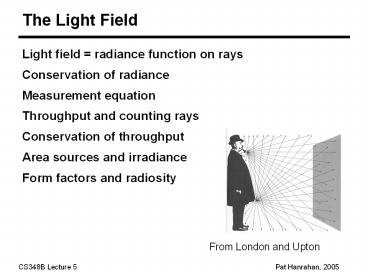The Light Field PowerPoint PPT Presentation
Title: The Light Field
1
The Light Field
- Light field radiance function on rays
- Conservation of radiance
- Measurement equation
- Throughput and counting rays
- Conservation of throughput
- Area sources and irradiance
- Form factors and radiosity
From London and Upton
2
Light Field Radiance(Ray)
3
Field Radiance
- Definition The field radiance (luminance) at a
- point in space in a given direction is the power
- per unit solid angle per unit area perpendicular
- to the direction
- Radiance is the quantity associated with a ray
4
Light Probe ? Environment Map
Miller and Hoffman, 1984
5
Properties of Radiance
6
Properties of Radiance
- Fundamental field quantity that characterizes the
distribution of light in an environment. - Radiance is a function on rays
- All other field quantities are derived from it
- Radiance invariant along a ray.
- 5D ray space reduces to 4D
- Response of a sensor proportional to radiance.
7
1st Law Conversation of Radiance
- The radiance in the direction of a light ray
remains - constant as the ray propagates
8
1st Law Conversation of Radiance
- The radiance in the direction of a light ray
remains - constant as the ray propagates
9
Spherical Gantry ? 4D Light Field
Capture all the light leaving an object - like a
hologram
10
Two-Plane Light Field
2D Array of Cameras
2D Array of Images
11
Multi-Camera Array ? Light Field
12
Throughput Counts Rays
- Define an infinitesimal beam as the set of rays
- intersecting two infinitesimal surface elements
- T measures/count the number of rays in the beam
13
Conservation of Throughput
- Throughput conserved during propagation
- Number of rays conserved
- Assuming no attenuation or scattering
- n2 (index of refraction) times throughput
invariant under the laws of geometric optics - Reflection at an interface
- Refraction at an interface
- Causes rays to bend (kink)
- Continuously varying index of refraction
- Causes rays to curve mirages
14
Conservation of Radiance
- Radiance is the ratio of two quantities
- 1. Power
- 2. Throughput
- Since power and throughput are conserved,
- ? Radiance conserved
15
Quiz
- Does radiance increase under a magnifying glass?
16
Quiz
- Does radiance increase under a magnifying glass?
No!!
17
Radiance 2nd Law
- The response of a sensor is proportional to the
- radiance of the surface visible to the sensor.
- L is what should be computed and displayed.
- T quantifies the gathering power of the device
the higher the throughput the greater the amount
of light gathered
18
Quiz
- Does the brightness that a wall appears to the
- sensor depend on the distance?
19
Measuring Rays Throughput
20
Throughput Counts Rays
- Define an infinitesimal beam as the set of rays
- intersecting two infinitesimal surface elements
- Measure/count the number of rays in the beam
21
Parameterizing Rays
- Parameterize rays wrt to receiver
22
Parameterizing Rays
- Parameterize rays wrt to source
23
Parameterizing Rays
- Tilting the surfaces reparameterizes the rays
- All these throughputs must be equal.
24
Projected Solid Angle
25
Parameterizing Rays S2 R2
- Parameterize rays by
- Measuring the number or rays that hit a shape
Projected area
Sphere
26
Parameterizing Rays M2 S2
- Parameterize rays by
Croftons Theorem
27
Incident Surface Radiance
- Definition The incoming surface radiance
- (luminance) is the power per unit solid angle per
- unit projected area arriving at a receiving
surface
28
Exitant Surface Radiance
- Definition The outgoing surface radiance
- (luminance) is the power per unit solid angle per
- unit projected area leaving at surface
- Alternatively the intensity per unit projected
area - leaving a surface
29
Irradiance from a Uniform Area Source
30
Irradiance from the Environment
31
Uniform Area Source
32
Uniform Disk Source
Geometric Derivation
Algebraic Derivation
33
Spherical Source
Geometric Derivation
Algebraic Derivation
34
The Sun
- Solar constant (normal incidence at zenith)
- Irradiance 1353 W/m2
- Illuminance 127,500 lm/m2 127.5 kilolux
- Solar angle
- .25 degrees .004 radians (half angle)
- 6 x 10-5 steradians
- Solar radiance
35
Polygonal Source
36
Polygonal Source
37
Polygonal Source
38
Lamberts Formula
39
Penumbras and Umbras
40
Form Factors
41
Types of Throughput
- 1. Infinitesimal beam of rays (radiance)
- 2. Infinitesimal-finite beam (irradiance calc.)
- 3. Finite-finite beam (radiosity calc.)
42
Probability of Ray Intersection
Probability of a ray hitting A given that it
hits A
43
Another Formulation
44
Form Factor
Probability of a ray hitting A given it hits
A Form factor definition Form factor
reciprocity
45
Radiosity
- Power transfer from a constant radiance source
- Set up system of
- equations representing
- power transfers
- between objects
46
Form Factors and Throughput
- Form factors represent the probability of ray
leaving a surface intersecting another surface - Only a function of surface geometry
- Differential form factor
- Irradiance calculations
- Form factors
- Radiosity calculations (energy balance)

